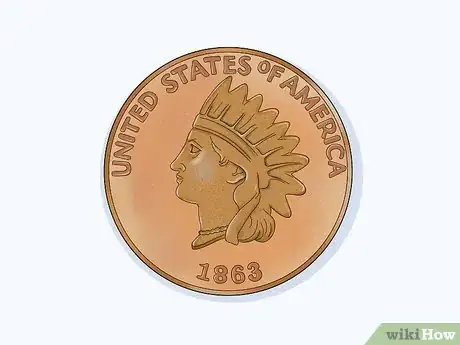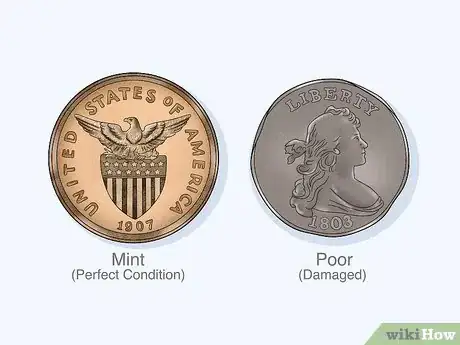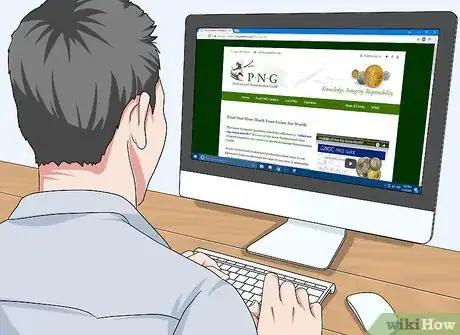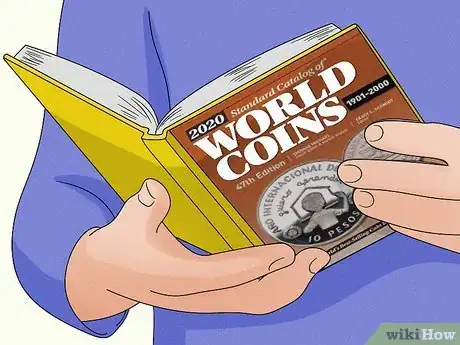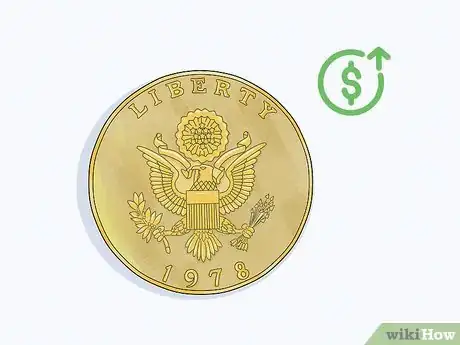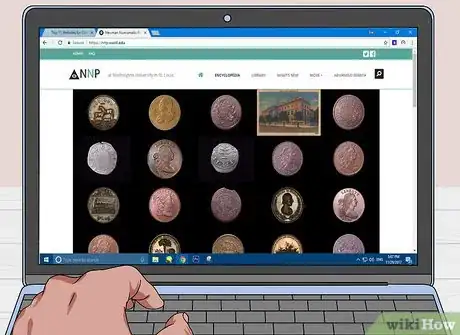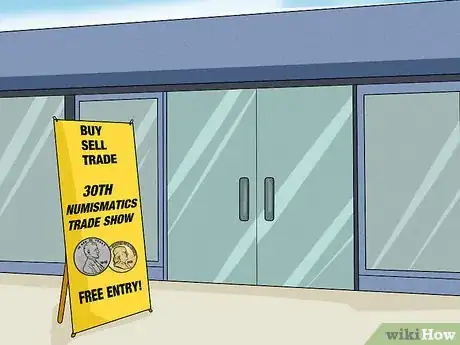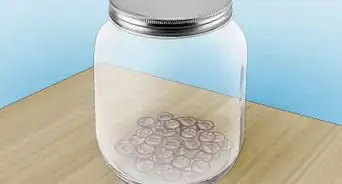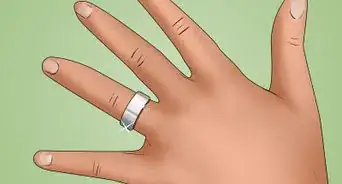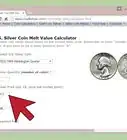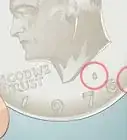This article was co-authored by wikiHow Staff. Our trained team of editors and researchers validate articles for accuracy and comprehensiveness. wikiHow's Content Management Team carefully monitors the work from our editorial staff to ensure that each article is backed by trusted research and meets our high quality standards.
wikiHow marks an article as reader-approved once it receives enough positive feedback. This article has 40 testimonials from our readers, earning it our reader-approved status.
This article has been viewed 911,470 times.
Learn more...
Coin collecting is a fun hobby, but collectors naturally want to know the value of their coins. This can be out of curiosity, or because they are interested in coins for investment purposes. Whatever your reason for collecting, start by figuring out exactly what type of coin you have, as well as its condition. You can then reference this information against online and print value lists. If you want to get an accurate value for your specific coin(s), work with a numismatics organization and a professional appraiser.
Things You Should Know
- Identify the coin’s date, location of origin, and condition. Compare your coin against listings online or in a coin value book to get an idea of its worth.
- A coin’s value depends on how interested people are in it. Coins that are rare, in mint condition, or commemorative are worth more than common ones.
- Join a numismatics group to ask about the value online, or visit an appraiser or a coin trade show to have it inspected and valued in person.
Steps
Doing Research
-
1Pin down the coin’s origin and date. You’ll need to know exactly what coin you're looking at to determine its specific value. Modern coins will include a date of issue printed on the front or back of the coin itself. They will probably also name the country of origin. Some also have other helpful information, such as a mint mark (a tiny letter printed somewhere on the coin that indicates where it was minted).
- If the information printed on the coin is printed in a language you can’t read, consult a world coin reference book or website. These will include images that will help you match your coin.
- These guides can also be used to help you determine how old coins without a printed date are.
- If you cannot find the coin in a book due to lack of identifiers, try to determine general area (i.e. Sinosphere, Islamic Countries, Core African). Broadening your search first may help you narrow in on the correct country.
-
2Inspect the coin to determine its condition. The value of a coin is greatly affected by its condition. Higher quality coins are generally more valuable than ones that are blemished or dirty.[1]
- Coins that were never used are known as uncirculated.
- Coins are rated from “mint” (perfect) condition, all the way down to “poor” (dirty or damaged).
- If you have a coin that you think might be rare or valuable, don’t attempt to clean it yourself. Take it to an expert to have it cleaned without damaging it and lowering its value. Eye appeal is not what counts
- If a coin is severely damaged, it might just be worth the value of the metal itself.
Advertisement -
3Check coin value lists online. Some websites will make values for some coins freely available. Check with a professional organization like the Professional Numismatics Guild. Look up your coin according to its date and origin, and you may be able to find its current value.[2]
- A number of factors (including condition and current demand) impact the amount a coin can actually be sold for, so use the value you find online only as a ballpark figure.
-
4Consult a coin value book. If you can’t find the value of your coin online, consult a reference such as the Standard Catalog of World Coins, or the Guide Book of United States Coins. These references are especially useful because they may list several values for a particular coin:[3]
- The “book” value (a generally accepted value of the coin)
- The “buy” value (what a dealer would pay to buy the coin from you)
- The retail value (what a dealer would sell a coin to a customer for)
- The wholesale value (what a dealer might sell the coin to another dealer for, especially when several coins are sold together)
-
5Account for any special factors. The value of coins can go up and down, since they are driven by interests that can change. When lots of people want to buy a certain type of coin, the value may go up. Rare coins or coins in unusually fine condition are often more valuable than common ones. Finally, commemorative (special issue) coins may also be especially valuable.[4]
- Take these values into account when calculating the value of your coin. For instance, you may have a type of coin that is not especially rare. However, if it is in mint condition, and most coins of that type are not, its value may be higher than the normal “book” value.
Working with an Appraiser
-
1Join a numismatics group. The study of coins and other money is known as numismatics. If you have lots of coins that you want to appraise, or if you frequently work with coins, consider joining a professional group devoted to this area. These groups will share price lists and other special information that can help you determine the value of your coins.[5]
- Look for a recognized professional group in your area, like the American Numismatics Association or the Professional Numismatics Guild.
- Websites like Coin Today and Coin World may also allow you to register for membership to access special information.
- Many coin groups can also help you determine the value of other types of objects, such as rare papery money, tokens, or medallions.
-
2Have your coin officially appraised. Professional coin appraisers can give you the most accurate, up-to-date value of your coin. They will base their appraisal on their expert opinion of the coin’s condition. They’ll also take into account what similar coins have been selling for lately.[6]
- Membership in a numismatics group should also give you access a directory of dealers so you can find one in your area.
-
3Go to a numismatics trade show. Coin groups may hold regular conventions where sellers can display coins for interested buyers. Dealers may also be interested in buying coins from attendees. Whether or not you’re interested in actually selling your coin, you can use this as an opportunity to determine its “buy” value.[7]
- Talk to some dealers. Show them the coin(s) you have and ask them if they’re interested in buying.
Community Q&A
-
QuestionWhat is the value of a one cent Indian head from 1904?
 Community AnswerAbout 3-5 dollars, depending on the date and condition. Hundreds of millions of those exist, so they're not rare.
Community AnswerAbout 3-5 dollars, depending on the date and condition. Hundreds of millions of those exist, so they're not rare. -
QuestionHow do I sell a penny from 1866?
 Community AnswerGet it appraised by an expert before selling it and then sell it online. There is a big collectible coin market.
Community AnswerGet it appraised by an expert before selling it and then sell it online. There is a big collectible coin market. -
QuestionHow can I identify where a coin is from?
 Community AnswerUsually the older the coin is, the more valuable it is. The year the coin was made in is almost always somewhere on the coin. There are exceptions of course.
Community AnswerUsually the older the coin is, the more valuable it is. The year the coin was made in is almost always somewhere on the coin. There are exceptions of course.
References
- ↑ http://www.prattlibrary.org/research/tools/index.aspx?id=5739&idx=abc
- ↑ https://pngdealers.org/price-guide/
- ↑ https://www.money.org/FAQ
- ↑ http://www.prattlibrary.org/research/tools/index.aspx?id=5739&idx=abc
- ↑ http://www.prattlibrary.org/research/tools/index.aspx?id=5739&idx=abc
- ↑ http://www.prattlibrary.org/research/tools/index.aspx?id=5739&idx=abc
- ↑ http://www.prattlibrary.org/research/tools/index.aspx?id=5739&idx=abc
- ↑ https://www.ngccoin.com/price-guide/coin-melt-values.aspx
- ↑ https://www.consumer.ftc.gov/articles/0136-investing-collectible-coins
About This Article
To find the value of an old coin, start by examining the front and back of the coin for a date and country of origin. Next, rate the coin's current condition somewhere between “mint,” which means it's in perfect condition, and “poor," which indicates that it's dirty or damaged. Once you have the date, origin, and condition nailed down, use coin value lists posted online by professional organizations like the Professional Numismatics Guild to check how much it's worth. If you can’t find the value of your coin online, consult a reference book like the Standard Catalog of World Coins. If you still aren't sure about the value or if you can't find the coin listed anywhere, your best bet is to contact an appraiser for a professional opinion. For tips on finding reliable appraisers, read on!
